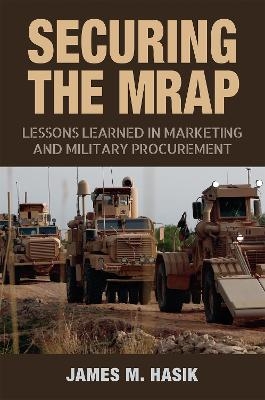
Securing the MRAP
Lessons Learned in Marketing and Military Procurement
Seiten
2021
Texas A & M University Press (Verlag)
978-1-62349-942-6 (ISBN)
Texas A & M University Press (Verlag)
978-1-62349-942-6 (ISBN)
The mine-resistant, ambush-protected vehicle, or MRAP, required years of entrepreneurial marketing by the defense industry. In Securing theMRAP, James Hasik explores how these vehicles, which the American military mostly rejected despite the great need for them, eventually came to be adopted as the Pentagon's top procurement priority.
Dwight D. Eisenhower once quipped, 'You will not find it difficult to prove that battles, campaigns, and even wars have been won or lost primarily because of logistics'. Military acquisition and procurement - that is, how a nation manages investments, technologies, programs, and support - is critical to wartime success or failure. When unexpected battlefield problems arise, how do the government, the military, and industry work together to ensure effective solutions?During the American counterinsurgent campaign in Iraq, the improvised explosive device emerged as a disruptive and devastating threat. As Humvees, and their occupants, were ripped apart by IEDs, it was clear that new solutions had to be found. These solutions already existed but had not been procured, highlighting the need for more effective marketing to the military by industry. The ultimate successful response - the mine-resistant, ambush-protected vehicle, or MRAP - required years of entrepreneurial marketing by the defense industry.
In Securing theMRAP, James Hasik explores how these vehicles, which the American military mostly rejected despite the great need for them, eventually came to be adopted as the Pentagon's top procurement priority. Hasik traces the story of the MRAP from the early 1970s to the future of mine-resistant vehicles on the battlefields of tomorrow.
An important contribution to the seemingly disparate fields of marketing and defence policy, Securing the MRAP is an eye-opening revelation to defence industrialists, military officers, and government officials who want to understand how to avoid another IED-Humvee debacle.
Dwight D. Eisenhower once quipped, 'You will not find it difficult to prove that battles, campaigns, and even wars have been won or lost primarily because of logistics'. Military acquisition and procurement - that is, how a nation manages investments, technologies, programs, and support - is critical to wartime success or failure. When unexpected battlefield problems arise, how do the government, the military, and industry work together to ensure effective solutions?During the American counterinsurgent campaign in Iraq, the improvised explosive device emerged as a disruptive and devastating threat. As Humvees, and their occupants, were ripped apart by IEDs, it was clear that new solutions had to be found. These solutions already existed but had not been procured, highlighting the need for more effective marketing to the military by industry. The ultimate successful response - the mine-resistant, ambush-protected vehicle, or MRAP - required years of entrepreneurial marketing by the defense industry.
In Securing theMRAP, James Hasik explores how these vehicles, which the American military mostly rejected despite the great need for them, eventually came to be adopted as the Pentagon's top procurement priority. Hasik traces the story of the MRAP from the early 1970s to the future of mine-resistant vehicles on the battlefields of tomorrow.
An important contribution to the seemingly disparate fields of marketing and defence policy, Securing the MRAP is an eye-opening revelation to defence industrialists, military officers, and government officials who want to understand how to avoid another IED-Humvee debacle.
James Hasik is associate professor of industrial studies at the Dwight D. Eisenhower School of National Security and Resource Strategy at the National Defense University, Fort McNair, Washington DC. He is the author of Arms and Innovation: Entrepreneurship and Alliances in the Twenty-First-Century Defense Industry and coauthor of The Precision Revolution: GPS and the Future of Aerial Warfighting.
| Erscheinungsdatum | 06.08.2021 |
|---|---|
| Reihe/Serie | Williams-Ford Texas A&M University Military History Series |
| Zusatzinfo | 24 black & white photos, Chart |
| Verlagsort | College Station |
| Sprache | englisch |
| Maße | 152 x 229 mm |
| Gewicht | 333 g |
| Themenwelt | Geisteswissenschaften ► Geschichte ► Allgemeines / Lexika |
| Geschichte ► Teilgebiete der Geschichte ► Militärgeschichte | |
| Sozialwissenschaften ► Politik / Verwaltung ► Staat / Verwaltung | |
| Technik | |
| ISBN-10 | 1-62349-942-9 / 1623499429 |
| ISBN-13 | 978-1-62349-942-6 / 9781623499426 |
| Zustand | Neuware |
| Haben Sie eine Frage zum Produkt? |
Mehr entdecken
aus dem Bereich
aus dem Bereich
neueste Manipulationstechniken als Waffengattung der NATO
Buch | Softcover (2023)
Westend (Verlag)
CHF 33,55
Deutschlands Schwäche in der Zeitenwende
Buch | Softcover (2023)
C.H.Beck (Verlag)
CHF 25,20


